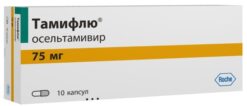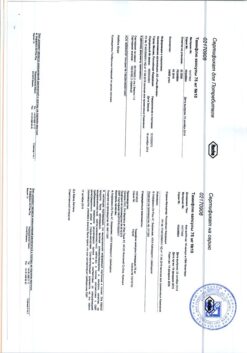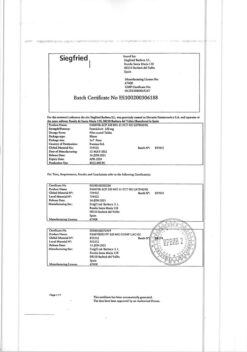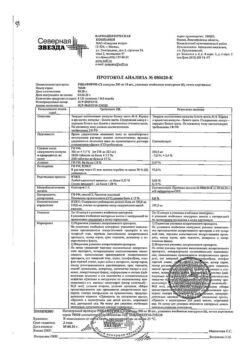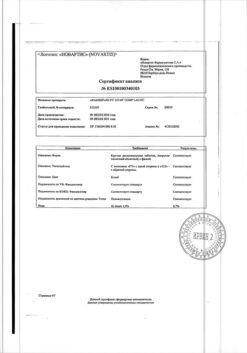No products in the cart.
Description
Pharmacotherapeutic group: Antiviral drug
Pharmacological action
Antiviral drug, guanosine nucleoside analogue with potent and selective activity against hepatitis B virus (HBV) polymerase.
Entecavir is phosphorylated to form active triphosphate with an intracellular half-life of 15 h. The intracellular concentration of entecavir triphosphate is directly related to the extracellular level of entecavir, with no significant accumulation of the drug after the initial “plateau” level. By competing with its natural substrate, deoxyguanosine triphosphate, entecavir triphosphate inhibits all 3 functional activities of viral polymerase: 1) HBV polymerase priming, 2) reverse transcription of negative strand from pregenomic iRNA, and 3) synthesis of positive strand HBV DNA. Entecavir triphosphate is a weak inhibitor of cellular DNA polymerases α, β and δ with a Ki of 18-40 μM. In addition, at high concentrations of entecavir triphosphate and entecavir, no adverse effects were noted with respect to γ polymerase and DNA synthesis in mitochondria of HepG2 cells.
Pharmacokinetics
In healthy subjects, absorption of entecavir is rapid, Cmax in plasma is determined after 0.5-1.5 h. When entecavir is taken repeatedly at a dose of 0.1 to 1 mg, a dose-proportional increase in Cmax and AUC is noted. The equilibrium state is reached after 6-10 days of oral administration once daily, with plasma concentrations increasing approximately 2-fold. Cmax and Cmin in plasma at equilibrium were 4.2 and 0.3 ng/ml, respectively, when the drug was taken at a dose of 500 mcg; 8.2 and 0.5 ng/ml, respectively, when it was taken at a dose of 1 mg. In oral administration of entecavir at a dose of 500 mcg with both high-fat and low-fat foods, minimal delay in absorption (1-1.5 h when taken with food and 0.75 h when taken on an empty stomach), a 44-46% decrease in Cmax and an 18-20% decrease in AUC were observed.
The Vd of entecavir exceeded total body water, indicating good tissue penetration of the drug. The in vitro binding of entecavir to human plasma proteins is about 13%.
Entecavir is not a substrate, inhibitor or inducer of P450 isoenzymes. No oxidized or acetylated metabolites were determined after administration of labeled 14C-entecavir in humans and rats, and few phase II metabolites (glucuronides and sulfates) were determined.
After reaching Cmax, the plasma concentration of entecavir decreased biexponentially, with a T1/2 of 128-149 h. There was a 2-fold increase in drug concentration (cumulation) when taken once daily, meaning that the effective T1/2 was approximately 24 h.
Entecavir is excreted primarily by the kidneys, with 62-73% of the dose in the urine unchanged in equilibrium. Renal clearance is independent of dose and ranges from 360 to 471 mL/min, indicating glomerular filtration and tubular secretion of entecavir.
Indications
Indications
Chronic hepatitis B in adults with:
compensated liver damage and the presence of viral replication, increased levels of serum transaminases (alanine aminotransferase, ALT; or aspartate aminotransferase, AST) and histological signs of inflammatory process in the liver and/or fibrosis;
decompensated liver damage.
Pharmacological effect
Pharmacological effect
Pharmacotherapeutic group: Antiviral agent
Pharmacological action
An antiviral agent, a guanosine nucleoside analogue with potent and selective activity against hepatitis B virus (HBV) polymerase.
Entecavir is phosphorylated to form the active triphosphate, which has an intracellular half-life of 15 hours. The intracellular concentration of entecavir triphosphate is directly related to the extracellular levels of entecavir, and there is no significant accumulation of the drug after the initial plateau level. By competing with the natural substrate, deoxyguanosine triphosphate, entecavir triphosphate inhibits all 3 functional activities of the viral polymerase: 1) HBV polymerase priming, 2) negative strand reverse transcription from pregenomic mRNA, and 3) positive strand HBV DNA synthesis. Entecavir triphosphate is a weak inhibitor of cellular DNA polymerases α, β and δ with a Ki of 18-40 μM. In addition, at high concentrations of entecavir triphosphate and entecavir, no side effects were observed in relation to γ polymerase and DNA synthesis in the mitochondria of HepG2 cells.
Pharmacokinetics
In healthy people, the absorption of entecavir is rapid, Cmax in the blood plasma is determined after 0.5-1.5 hours. When entecavir is taken repeatedly in a dose of 0.1 to 1 mg, a dose-proportional increase in Cmax and AUC is observed. An equilibrium state is achieved after 6-10 days of oral administration once a day, while the plasma concentration increases approximately 2 times. Cmax and Cmin in plasma at steady state were 4.2 and 0.3 ng/ml, respectively, when taking the drug at a dose of 500 mcg, 8.2 and 0.5 ng/ml, respectively, when taking the drug at a dose of 1 mg. When entecavir was taken orally at a dose of 500 mcg with both a high-fat and low-fat meal, there was a minimal delay in absorption (1-1.5 hours when taken with food and 0.75 hours when taken on an empty stomach), a decrease in Cmax by 44-46% and a decrease in AUC by 18-20%.
Vd of entecavir exceeded the total volume of water in the body, which indicates good penetration of the drug into tissues. The binding of entecavir to human plasma proteins in vitro is about 13%.
Entecavir is not a substrate, inhibitor or inducer of P450 isoenzymes. After administration of 14C-labeled entecavir to humans and rats, no oxidized or acetylated metabolites were detected, and phase II metabolites (glucuronides and sulfates) were detected in small quantities.
After reaching Cmax, the concentration of entecavir in plasma decreased biexponentially, with T1/2 being 128-149 hours. When taken 1 time/day, the concentration of the drug increased (cumulation) by 2 times, that is, the effective T1/2 was approximately 24 hours.
Entecavir is excreted mainly by the kidneys, and at steady state, 62-73% of the dose is determined unchanged in the urine. Renal clearance is independent of dose and ranges from 360 to 471 ml/min, indicating glomerular filtration and tubular secretion of entecavir.
Special instructions
Special instructions
Lactic acidosis/severe hepatomegaly with steatosis
When treated with nucleoside analogues, cases of lactic acidosis and severe hepatomegaly with steatosis have been described, sometimes leading to the death of the patient. Since entecavir is a nucleoside analogue, the risk of developing this complication cannot be excluded when using it.
Symptoms that may indicate the development of lactic acidosis: general fatigue, nausea, vomiting, abdominal pain, sudden weight loss, shortness of breath, rapid breathing, muscle weakness. In severe cases, sometimes fatal, the development of lactic acidosis has been associated with pancreatitis, liver failure/steatosis, renal failure and hyperlactatemia. Risk factors include female gender, obesity, long-term use of nucleoside analogs, and hepatomegaly.
Treatment with nucleoside analogues should be discontinued if symptomatic hyperlactatemia and metabolic acidosis/lactic acidosis, progressive hepatomegaly, or a rapid increase in aminotransferase levels develop. Caution should be exercised when using nucleoside analogs to treat any patient (especially obese women) with hepatomegaly, hepatitis, or other known risk factors for liver injury and hepatic steatosis (including use of certain drugs and alcohol use). Careful clinical and laboratory monitoring is required when treating such patients.
To distinguish an increase in aminotransferase activity as evidence of treatment response from an increase potentially associated with lactic acidosis, the clinician should ensure that changes in ALT activity are associated with improvements in other laboratory markers of chronic hepatitis B.
Exacerbations of hepatitis
Spontaneous exacerbations of chronic hepatitis B are quite common and are characterized by a transient increase in serum ALT activity. After starting antiviral therapy, some patients may experience an increase in ALT activity due to a decrease in the level of HBV DNA in the blood serum. In most cases, exacerbation of hepatitis developed during the first 4-5 weeks of entecavir therapy. In patients with compensated liver disease, this increase in ALT activity is usually not accompanied by an increase in serum bilirubin concentrations or liver failure. Patients with advanced liver disease or cirrhosis have an increased risk of liver decompensation. When treating such patients, careful clinical and laboratory monitoring should be performed.
Cases of exacerbation of hepatitis have also been reported in patients who stopped taking medications for the treatment of hepatitis B. Exacerbations after discontinuation of treatment are usually associated with an increase in the level of HBV DNA, in most cases do not lead to decompensation of liver function and stop spontaneously. However, severe exacerbations, including deaths, have been reported.
Among patients who had not previously received nucleoside analogues and were prescribed entecavir, an exacerbation developed on average within the first 23-24 weeks after discontinuation of the drug, in most cases in HBeAg-negative patients (see section “Side effects”). Liver function should be monitored periodically for at least 6 months after discontinuation of hepatitis therapy. If necessary, restarting hepatitis B medications may be warranted.
Patients with hepatitis B/HIV co-infection
It should be taken into account that when prescribing entecavir to patients co-infected with HIV who are not receiving highly active antiretroviral therapy (HAART), there may be a risk of developing resistant strains of HIV. Therefore, entecavir should not be used in patients with hepatitis B/HIV co-infection who are not receiving HAART. Entecavir has not been studied as a treatment for HIV infection and is not recommended for such use.
Patients with combined hepatitis B/hepatitis C/hepatitis D infection
There are no data on the effectiveness of entecavir in patients with combined hepatitis B/hepatitis C/hepatitis D infections.
Patients with decompensated liver disease
There is a high risk of serious liver side effects, particularly in patients with decompensated liver disease class C according to the Child-Pugh classification. These patients are also at greater risk of developing lactic acidosis and specific renal side effects such as hepatorenal syndrome. In this regard, patients should be carefully monitored to identify clinical signs of lactic acidosis and renal dysfunction, as well as appropriate laboratory tests should be carried out in this group of patients (liver enzyme activity, lactic acid concentration in the blood, creatinine concentration in the blood serum).
Lamivudine-resistant patients
Lamivudine-resistant patients are at higher risk of subsequent development of entecavir resistance than patients without lamivudine resistance. The probability of developing genotypic resistance to entecavir after 1, 2, 3, 4 and 5 years of treatment in studies of lamivudine-resistant patients was 6%, 15%, 36%, 47% and 51%, respectively. In this regard, lamivudine-resistant patients require frequent monitoring of the viral load and appropriate testing to detect resistance. In patients with a suboptimal virological response after 24 weeks of treatment with entecavir, a change in treatment regimen should be considered. When starting therapy in patients with documented HBV resistance to lamivudine, entecavir in combination with another antiviral drug (not cross-resistant with lamivudine or entecavir) should be preferred over entecavir monotherapy.
The presence of HBV resistance to lamivudine is associated with an increased risk of developing resistance to entecavir, regardless of the degree of liver dysfunction. In patients with decompensated liver disease, virological breakthrough may be associated with serious clinical complications of liver disease. Therefore, in lamivudine-resistant patients with decompensated liver disease, the use of entecavir in combination with another antiviral drug that does not have cross-resistance with lamivudine or entecavir is preferable to entecavir monotherapy.
Patients with impaired renal function
For patients with impaired renal function, adjustment of the dosage regimen is recommended (see section “Dosage and Administration”). The proposed recommendations are based on extrapolation of limited data; the safety and effectiveness of these regimens have not been clinically evaluated. Therefore, virological response should be carefully monitored in patients with renal impairment.
Patients who have undergone liver transplantation
The safety and effectiveness of entecavir in patients undergoing liver transplantation are unknown. Renal function should be carefully monitored before and during treatment with entecavir in patients who have undergone liver transplantation and are receiving immunosuppressants that may affect renal function, such as cyclosporine and tacrolimus.
General information for patients
Patients should be informed that entecavir therapy does not reduce the risk of transmission of hepatitis B and, therefore, appropriate precautions should be taken. Each tablet of the drug contains 54.47 mg (0.5 mg tablets) or 108.94 mg (1.0 mg tablets) of lactose monohydrate. In this regard, patients with rare hereditary lactose intolerance, lactase deficiency or glucose-galactose malabsorption are contraindicated in taking the drug.
Impact on the ability to drive vehicles and machinery
During the period of treatment, it is necessary to refrain from driving vehicles and engaging in potentially hazardous activities that require increased concentration and speed of psychomotor reactions, since the drug can cause dizziness and other side effects that can affect these abilities.
Active ingredient
Active ingredient
Entecavir
Composition
Composition
Each film-coated tablet contains:
Active ingredient:
Entecavir monohydrate – 0.53 mg/1.06 mg, in terms of entecavir – 0.5 mg
Excipients:
Core: lactose monohydrate – 54.47 mg; microcrystalline cellulose – 90 mg; low-substituted hyprolose – 40 mg; povidone K30 – 5 mg; crospovidone – 8 mg/16 mg; colloidal silicon dioxide – 1 mg; magnesium stearate – 1 mg.
Film coating: hypromellose E5 – 4.2 mg; macrogol 6000 – 0.54 mg; titanium dioxide – 1.2 mg; polysorbate 80 – 0.06 mg.
Pregnancy
Pregnancy
Pregnancy
There are no adequate and well-controlled studies in pregnant women. Entecavir should be taken during pregnancy only if the potential benefit outweighs the potential risk to the fetus.
Breast-feeding
There is no data on the penetration of entecavir into human milk. Breastfeeding while using the drug is not recommended.
Contraindications
Contraindications
Hypersensitivity to entecavir or any other component of the drug;
Children under 18 years of age;
Rare hereditary lactose intolerance, lactase deficiency or glucose-galactose malabsorption.
Side Effects
Side Effects
From the digestive system
Rarely (≥ 1/1000, < 1/100): diarrhea, dyspepsia, nausea, vomiting.
From the central nervous system
Often (≥ 1/100, < 1/10): headache, fatigue; rarely (≥ 1/1000, < 1/100): insomnia, dizziness, drowsiness.
Post-marketing data (frequency cannot be determined):
From the immune system: anaphylactoid reaction.
From the skin and subcutaneous tissue: alopecia, rash.
From the liver: increased transaminase activity.
Metabolism: lactic acidosis (general fatigue, nausea, vomiting, abdominal pain, sudden weight loss, shortness of breath, rapid breathing, muscle weakness), especially in patients with decompensated liver damage.
In addition, in patients with decompensated liver damage, the following additional side effects were observed:
Often: decrease in bicarbonate concentration in the blood, increase in ALT activity and bilirubin concentration by more than 2 times compared to the upper limit of normal, albumin concentration less than 2.5 g/dL, increase in lipase activity by more than 3 times compared to normal, platelet concentration below 50,000/mm3; rarely: renal failure.
Selected adverse reactions
Exacerbations of hepatitis during treatment
In clinical studies in nucleoside analogue-naive patients, exacerbation of hepatitis (increased ALT activity more than 10 times the upper limit of normal and more than 2 times the baseline) was observed in 2% of patients receiving entecavir compared with 4% of patients receiving lamivudine. In lamivudine-resistant patients, an increase in ALT activity of more than 10 times the upper limit of normal and more than 2 times the baseline level was detected in 2% of patients receiving entecavir, compared with 11% of patients receiving lamivudine. Among patients treated with entecavir who experienced increased ALT activity, the median time to symptom onset was 4-5 weeks. Typically, resolution of symptoms is noted with continued treatment. In most cases, the increase in ALT activity was associated with a decrease in viral load of 2 log10/ml or more, which preceded or coincided with the increase in ALT activity. During treatment, periodic monitoring of liver function is recommended.
Exacerbation of hepatitis after cessation of treatment
There are reports of cases of exacerbation of hepatitis in patients who stopped taking drugs for the treatment of hepatitis B, including after stopping entecavir. In studies of nucleoside analogue-naïve patients, 6% of patients treated with entecavir and 10% of patients treated with lamivudine experienced an increase in ALT activity (more than 10 times the upper limit of normal and more than 2 times the baseline) during follow-up after treatment. Among patients not previously treated with nucleoside analogues, after stopping entecavir therapy, the median time to ALT elevation was 23-24 weeks, with 86% (24/28) of HBeAg-negative patients. In studies involving a limited number of lamivudine-resistant patients, 11% of patients treated with entecavir and not taking lamivudine experienced an increase in ALT activity during follow-up.
In clinical studies, entecavir therapy was discontinued if patients achieved a predefined response. If therapy is discontinued without regard to treatment response, changes in ALT activity may be more likely.
Special patient groups
Patients with decompensated liver disease
The safety profile of entecavir in patients with decompensated liver disease was assessed in an open-label, comparative, randomized clinical trial in which patients received entecavir 1 mg daily (n = 102) or adefovir dipivoxil 10 mg daily (n = 89). In this study, the cumulative mortality rate was 23% (23/102). The cause of death was usually liver disease. The cumulative incidence of hepatocellular carcinoma was 12% (12/102). Serious adverse events, usually liver-related, occurred at a cumulative incidence of 69%. Patients with a high Child-Pugh score were at higher risk of developing serious side effects.
Laboratory test abnormalities
Up to 48 weeks after initiation of entecavir therapy in patients with decompensated liver disease, no patient had an increase in ALT activity greater than 10 times the upper limit of normal and more than 2 times the baseline level. In 1% of patients, there was an increase in ALT activity by more than 2 times compared to the initial level with a simultaneous increase in bilirubin levels by more than 2 times compared to the upper limit of normal and more than 2 times compared to the initial level. A decrease in albumin level < 2.5 g/dL occurred in 30% of patients, an increase in lipase level more than 3 times compared to baseline in 10% of patients, and a decrease in platelet count < 50,000/mm3 in 20% of patients.
Patients with hepatitis B/HIV co-infection
The safety profile of entecavir in a limited number of hepatitis B/HIV coinfected patients receiving highly active antiretroviral regimens containing lamivudine was similar to the safety profile in patients with HBV monoinfection.
Interaction
Interaction
Since entecavir is eliminated primarily by the kidneys, concomitant administration of entecavir and drugs that reduce renal function or compete at the level of tubular secretion may increase serum concentrations of entecavir or these drugs. When entecavir was co-administered with lamivudine, adefovir or tenofovir, no significant drug interactions were identified.
The interactions of entecavir with other drugs that are excreted by the kidneys or affect renal function have not been studied. Patients should be monitored closely if entecavir is co-administered with these drugs.
Overdose
Overdose
There are limited data on cases of drug overdose in patients. There were no unexpected adverse events in healthy volunteers receiving up to 20 mg per day for up to 14 days or single doses up to 40 mg. In case of overdose, the patient should be closely monitored medically and, if necessary, receive standard supportive care.
Manufacturer
Manufacturer
Pharmasintez JSC, Russia
Additional information
| Manufacturer | Pharmasintez JSC, Russia |
|---|---|
| Medication form | pills |
| Brand | Pharmasintez JSC |
Related products
Buy Elgravir, 0.5 mg 30 pcs with delivery to USA, UK, Europe and over 120 other countries.


